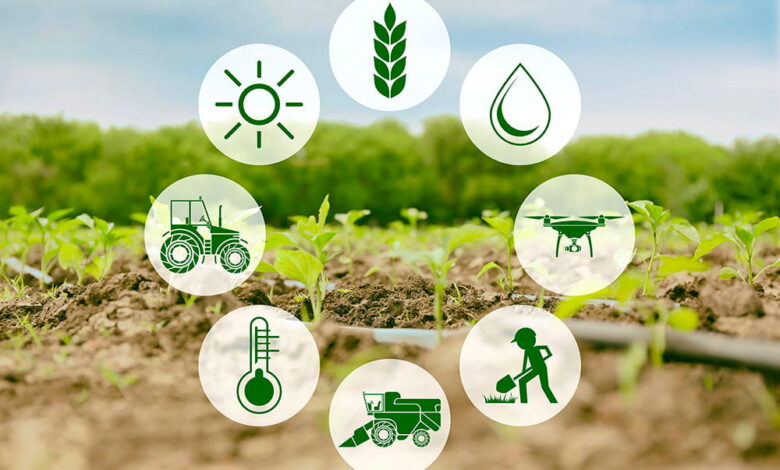Climate Change Is Impacting India’s Agriculture
Rising temperatures in India are projected to reduce crops yields, as food price inflation touches 11.51% in 2023

PIC COUSTESY : Lvivity
In a new analysis titled ‘Impacts of Climate Change on Agriculture in India’ Climate Trends compiles evidence to showcase the extent of India’s agricultural vulnerability amidst changing summer monsoon season, crucial to India’s highly dependent agrarian economy. The paper citing scientific evidence and public data suggests that summer monsoon rainfall has declined by 6% since the 1950s. In the central region of India, where about 60% of agriculture is rainfed, summer monsoon rains have declined by 10%. While the monsoon rains have weakened, the intensity of the rains has increased, triggering dangerous floods. These changes have resulted in direct crop production impacts, along with food price inflation and export shocks.
Agriculture loss attributed to impacts of climate change
● Limiting greenhouse gases and human caused pollution would have increased the average annual kharif rice harvest by 14.4% during 1985–1998 in major rice-producing states
● Temperature increases over the 1981-2001 period are estimated to have reduced wheat yields by 5.2% in the states of Punjab, Haryana, Uttar Pradesh, Uttarakhand, Bihar, Rajasthan, Madhya Pradesh, Maharashtra and Gujarat.
● Increased greenhouse gases together with human-caused pollution are estimated to have reduced wheat and rice yields in major states over 1980 to 2010 by 36% and 20%, respectively.
● In the Himalayan region, which has experienced a doubling of the rate of ice loss since 2000 compared to 1975-2000, apple cultivation has shifted from lower to higher elevations in order to track the required lower temperatures
● In the states of Assam, Bihar, Karnataka, Kerala, Madhya Pradesh, Maharashtra, Orissa, Uttar Pradesh, and West Bengal, the cumulative kharif rice harvest over the 1966-2002 period would have been almost 6% higher (around 75 million tons) in the absence of climate change
● Erratic monsoon in June and July 2023 delayed the sowing of the kharif crops, resulting in almost 9% less area sowed in early July, compared to the same time last year.
Dr. Akshay Deoras, Research Scientist at the National Centre for Atmospheric Science & Dept. of Meteorology, University of Reading, UK said, “Agriculture is one of the few sectors that is highly sensitive to even slight anomalies in weather conditions. Extreme weather events amplify these anomalies, and global warming fuels extreme weather events. The net result is that the agriculture sector is becoming more vulnerable to losses due to extreme weather. With growing emissions, the situation will become more challenging, increasing the burden on the agricultural economy and having a social bearing.”
Rahul Todmal, Assistant professor of Geography, University of Pune added, “Agronomic studies have already established that the warmer climatic conditions will never favour agricultural productivity. In fact, further temperature rise is most likely to reduce traditional rainfed as well as irrigated cash crops like Jowar, Bajra, Pulses, Sugarcane, Onion, Maize, etc. Also, with rising temperature on account of warming along with building El Nino may result in warm winters this season. This will again have a great impact on the wheat production in terms of quality as well as yield.”
Aarti Khosla, Director, Climate Trends said, “Agriculture is highly dependent on consistent climatic conditions, but increasing variability on account of global warming is having severe consequences. While Monsoon rains have reduced by 10% over the long term and have become inconsistent, the rise in extreme events such as heat, drought and floods has added drastically to agricultural challenges. Rice and wheat crops, both accounting for around 85% of total annual grain production, are highly sensitive to climate change impacts. 18% of India’s GDP is agri-dependent and over 40% of its labour workforce is employed in the sector. Any changes in these patterns affect the country’s economy and well-being at both the macro and micro level.”
Farmers perceptions of climate change impacts
● Apple growers in Kullu district attribute poor apple production to changing snowfall, temperature, rainfall patterns and extreme weather phenomena
● In Uttarakhand, farmers report erratic rainfall, diminishing agricultural yield and increases in temperature, with crop failures, migration to other places and flooding viewed as three major consequences of climate change
● In the Kangchenjunga Biosphere Reserve, most farmers perceive increasing temperatures and unpredictable patterns of rainfall, warmer and stronger winds, changes in the flowering times of crops, and increases in insect pests and diseases, especially in their cardamom crops
● In West Tripura, farmers report increased crop, animal and human diseases increased numbers of hot days, and decreased rainy days and annual rainfall
● In the Kancheepuram district in south India, farmers have reported delayed monsoon onset, intermittent dry spells and decreasing soil moisture as the critical factors affecting their crops
Devinder Sharma, Food Policy Analyst and Agriculture Researcher added, “Erratic rainfall patterns seen have maximum impact on agriculture as well as socio-economic impacts. On account of extreme weather events, Haryana is likely to register a shortfall in the crop output. Punjab has suffered a major setback due to unprecedented floods. Situation is no different in other parts of the country. Below normal rains or unevenly distributed rains for instance in East India, has not recorded any rainfall at all which in all probability will have an impact on Rice yield for the year. Irrigation also comes into focus because some regions never needed irrigation during the season. However, with long breaks during the Monsoon, we need to adapt irrigation measures as well. This will also have implications for groundwater use and recharge.”
Food Inflation Trends amidst increasing weather anomalies
● The cost of tomatoes domestically soared by more than 700%
● Increased onion prices in August 2023 resulted in the government imposing a 40% levy on onion exports
● Food price inflation reached 11.51% in July this year – the highest since January 2020
● The y-o-y inflation rate has increased for vegetables (37.34%), pulses (13.3%), grains (13%), spices (21.6%) and milk (8.3%), according to MoSPI.
Extreme Heat Impact
● Sudden increase in temperature in India in 2010 during a critical growth phase in wheat reduced yields by up to 20% in some districts
● Even a single heatwave during a critical growth phase has been shown to negatively impact wheat, maize and soybean yields
● Around 70% of the rural population of India relies on agriculture for their livelihoods
● 153 billion hours of work were lost across the world in 2017 due to heat exposure, 80% of which were lost in the agricultural sector
The writer of this article is Dr. Seema Javed, an environmentalist & a communications professional in the field of climate and energy




